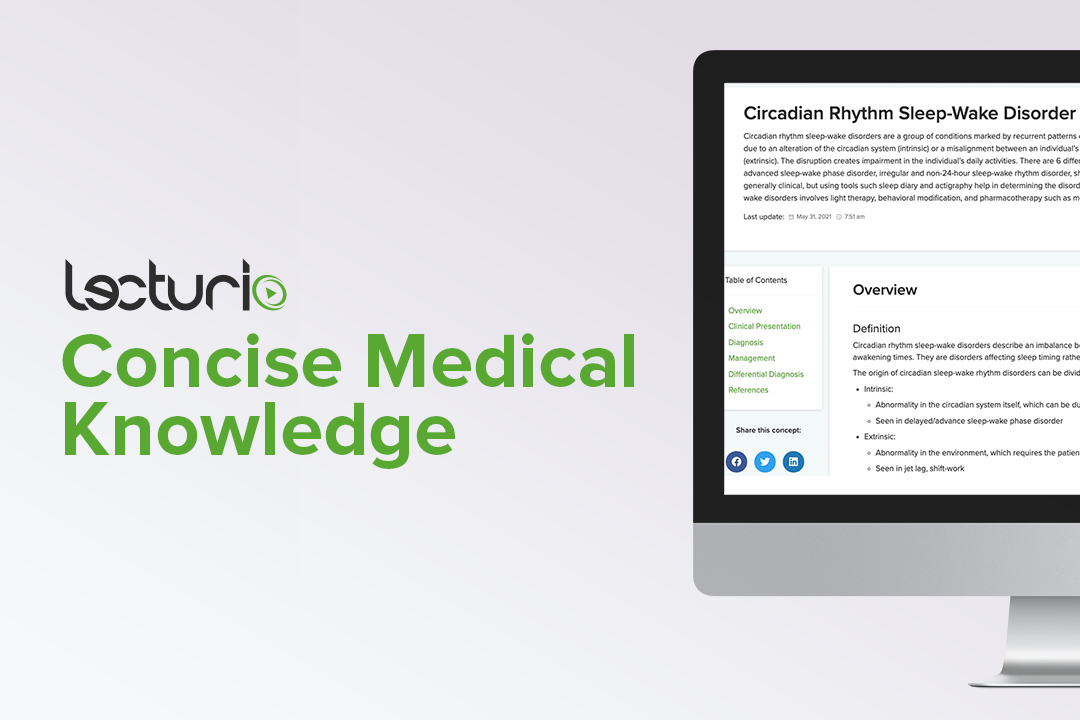Playlist
Show Playlist
Hide Playlist
Sleep-wake Phase Disorder: Management
-
Slides Sleep Disorders Circadian Rhythm.pdf
-
Download Lecture Overview
00:00 How do we diagnose a circadian rhythm sleep-wake disorder? Well, the diagnosis is made clinically. Polysomnography or a sleep study is not required but can be performed particularly to rule out other explanations. When we diagnose one of these disorders, a sleep diary is really helpful. It's useful as a self-reported tool to aid in the diagnosis and understand when the patient is going to bed, when they tend to get to sleep, and when they wake up. The patient is asked to record the bedtime, wake up time, total sleep time, estimated time that is required to fall asleep, and the frequency of awakenings at night. And this can help us to put together that pattern of sleep over a typical night and week. Actigraphy can also be helpful. This is a movement sensor worn on a patient's non-dominant wrist to determine the total amount of time and the sleep efficiency. This is useful in cases where a sleep diary is not feasible such as patients with neurodegenerative disorder or stroke or other conditions that may limit the quality of a sleep diary. Melatonin sampling can also be performed in particularly difficult or challenging cases. This can provide an objective assessment of impaired circadian rhythm. Melatonin is the key naturally occurring substance that helps to promote sleep. It's released by the pineal gland around 90-100 minutes before usual bedtime. And it is suppressed by bright lights when we wake up and the light stimulus hits our eyes, this suppresses further melatonin secretion. Dim light melatonin onset protocol can be used to measure melatonin secretion and evaluate for deficiency in melatonin secretion that could contribute to a change in the circadian rhythm. How do we manage patients with circadian rhythm disorders? Well, it depends on the disorder. 01:57 For delayed sleep-wake phase disorder, we talk about sleep hygiene, minimized light exposure during the evening to help bring that sleep onset time earlier in the evening. Light therapy during early morning can help promote a consistent wakefulness and also reset the circadian rhythm to earlier in the night. Melatonin can be administered early in the evening to promote earlier sleep and advancing bedtime each night can also be helpful where the patient starts at his or her normal hour of sleep and then moves it 1 hour earlier each night to the desired onset of sleep. Advanced sleep phase disorder. Management strategies here include light therapy in the afternoon or prior to bedtime, again to help modulate and reset the circadian rhythm. Irregular sleep-wake rhythm disorder. We think about light therapy in the morning to generate a consistent onset of wakening as well as behavioral interventions to consolidate sleep and increase daytime social and physical activities. For non-24-hour sleep-wake rhythm disorder, light therapy to have a consistent on of the brain, melatonin delivered at night to reset that circadian rhythm to a 24-hour period can also be helpful and then some melatonin agonist can be considered in selected patients. For shift worker sleep disorder, we think about light therapy as well as modafinil which can be a helpful wakefulness promoting agent taken at the time that the patient needs to wake up and go to work. 03:39 And then for jet lag disorder, this is often self-limited and doesn't need therapy, but melatonin can be helpful in some patients.
About the Lecture
The lecture Sleep-wake Phase Disorder: Management by Roy Strowd, MD is from the course Sleep Disorders.
Included Quiz Questions
What test uses a wrist sensor to monitor body movements and determine total sleep time and efficiency?
- Actigraphy
- EEG
- Polysomnography
- Melatonin sampling
- Kinetosomnolence testing
What is an effective non-pharmacologic intervention to manage both delayed and advanced sleep-phase disorders?
- Light therapy
- Cognitive behavioral therapy
- Stimulant therapy
- Exercise therapy
- Low-dose benzodiazepine therapy
What is an effective pharmacologic treatment that helps to address the underlying pathophysiology of a non-24-hour sleep–wake rhythm disorder?
- Melatonin
- Benzodiazepines
- Sedating antihistamines
- Sedating antidepressants
- Non-benzodiazepine sedatives
Customer reviews
5,0 of 5 stars
| 5 Stars |
|
5 |
| 4 Stars |
|
0 |
| 3 Stars |
|
0 |
| 2 Stars |
|
0 |
| 1 Star |
|
0 |




